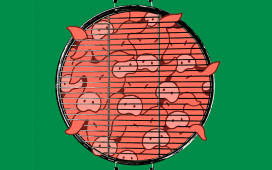Mid-pandemic, while undergoing a much-delayed Pap smear at a London hospital, and encountering a poster of some tulips that neither uplifted or offended me, I thought of a scene in Ben Lerner’s novel “10:04,” throughout which the protagonist undergoes various vaguely degrading medical experiences. “There was a poster of Picasso’s dove in the first neurologist’s waiting room, watercolors of Manhattan sunsets where they sent him for bloodwork, photographs of orchids where he waited for his CAT scan,” Lerner writes. The protagonist ponders asking his doctor, “Do you choose this stuff or does the hospital buy it in bulk?” He theorizes, irritably, “I understand the desire to have some decorations that indicate this isn’t just a hospital room, that a patient isn’t just a pathologized body. . . . it nods blandly to established cultural modes, the medium of painting and the cliched instance of it. They are images of art, not art.”
In her recent book, “ ‘Purpose-built’ Art in Hospitals: Art with Intent,” the nurse, artist, and academic Judy Rollins asks what the function and style of art in hospitals are and should be. Soothing or challenging? Figurative or abstract? Some advocate for the calming power of nature scenes, while others push for works of gallery quality: rousing, conceptual, complex. Rollins writes about the importance of curating differently depending on location—art selected for a maternity corridor may not be appropriate for an emergency waiting room. It is unfeasible, though, to attempt to control all responses. An image of a quiet landscape may comfort one patient, but for another, Rollins observes, “the scene might trigger an unpleasant memory (e.g., for a combat Veteran with posttraumatic stress disorder, an enemy awaiting behind the trees or barn).”
Rollins cites fifteen different “intents” for hospital art, including “art for empathy,” “art for inspiration and hope,” and “art for transcendence.” She argues that on some occasions—such as in cases where artists have chronicled their own illnesses—abstract work, or even art with dark or negative subject matter, can be instructional or enriching. Tools for collecting evidence about art can also be expanded, Rollins writes, thanks to brain-research techniques such as functional magnetic resonance imaging (fMRI), which maps neural activity. “Art is sensitive, so every method of measurement you use should be sensitive, too,” she told me via Zoom.
A handful of early adopters argued for the medical role of art. In “Notes on Nursing,” published in 1859, Florence Nightingale wrote, “The effect in sickness of beautiful objects, of variety of objects, and especially of brilliancy of colour is hardly at all appreciated.” Yet much of the Western medical establishment took little interest in the physical environments of hospitals until the late nineteen-seventies and early nineteen-eighties, when some researchers began arguing for the palliative potential of interiors and art work. One pioneer was Angelica Thieriot, who, after suffering from a viral infection, left a San Francisco hospital in 1978 outraged by the experience: the limited access for visitors, the lack of clarity about different procedures that her body would undergo, the general banality of the surroundings. In 1985, she established the Planetree model of “patient-centered” care, which advocates for hospital designs and treatment plans that offer more autonomy and empathy. Today, the Planetree organization advises hundreds of hospitals and governmental bodies, including the U.S. Department of Veterans Affairs, in twenty-five countries. It has introduced dimmer switches to tone down harsh lighting in hospital rooms, offered sculpture classes to patients and clowning classes to staff, and, at Griffin Hospital in Derby, Connecticut, installed a grand piano in the front lobby. Such innovations remain relatively rare, but most hospitals today will at least hang a pointedly inspirational mural of sunshine and blooming buds in the front hall. Perhaps there’s an art cart, from which patients can select works for their rooms.
Much of what we see in contemporary hospitals, including the tulips at my gynecology appointment, can be traced back to Roger Ulrich, the author of a small study conducted in a suburban Pennsylvania hospital, between 1972 and 1981. His research is cited, to this day, in nearly every article on hospital aesthetics. Twenty-three surgical patients were assigned rooms with windows looking out onto a small stand of trees, and twenty-three others were given rooms facing a brick wall. The former group had shorter hospital stays and took fewer painkillers than those with less verdant views, and nurses gave them more upbeat reports. Ulrich has referred to these findings to support a lush, green ideal for health-care art. According to him, works should be chosen only on the basis of whether they improve patient outcomes, and not because they receive praise from critics and artists, or approach gallery standards. His argument set a norm. It explains why COVID patients across the world have convalesced before images of landscapes, night skies, lush vegetables, and flowers, endless flowers—pictures that feel more like the backgrounds on corporate PowerPoint presentations than the result of an artist’s vision.
According to the nature-art advocates, other kinds of art work, particularly abstract paintings, can disturb patients. Ann Sloan Devlin, the author of “Transforming the Doctor’s Office: Principles from Evidence-based Design,” told me that she would advise staying away from anything that leaves patients unsure of what they are looking at. “If people are ill and already being challenged, I don’t think that’s where you want to challenge people,” she said. The goal seems to be, as Lerner wrote in “10:04,” the suggestion of art—the inference that work has been done to break from the generic “sick person’s environment,” as Devlin called it, but without shattering expectations to the point that patients lose faith in where they are, the procedures they’re facing, or the people in charge around them. Along this line of thinking, a stock photo of a night sky, framed and hung as if precious, would be preferable to a print of Van Gogh’s “The Starry Night,” with its mesmerizing swirls and undulating curves. The inclusion of either would evince thoughtfulness and care, but the former would be less likely to excite, confuse, or rile patients. The presence of “art” could be registered with a brief glance, without demanding that they overthink the content.
How should we define a sick person’s environment? The various four walls that contained us through lockdown—whether those of living rooms, hospitals, schoolrooms, or prisons—have offered a new framework for thinking about health and well-being. In the new book “The Topography of Wellness,” the architect and professor of architecture Sara Jensen Carr notes that, in the U.S. pre-pandemic, chronic disease had overtaken infectious disease as the primary cause of mortality. Yet, she told me, “so much of the idea of health is built around the idea of germs.” This has led to the stark, wiped-clean look of hospitals—the “aesthetic of clean,” as she put it. (This aesthetic intensified with the “hygiene theatre” of the pandemic, as institutions remained fixated on frequent surface cleaning long after research established that surface transmission of COVID was highly unlikely.) The visual divisions between medical environments and the rest of the world—the opposition between the sterilized and muted and the messy, bright, and lively—are not necessarily helpful to patients, Carr said, and art is a way to dissolve these boundaries. It can help make a hospital feel more comfortable, reducing the sense of stigma for those forced to be there, and it can be a nod to life outside the medical bubble—a needed reminder that sickness can play out beyond the white walls of treatment rooms. Art can be a bridge, a connection. But overrelying on nature scenes as a distraction or “tonic” might be problematic. A canvas showing a rolling green field in a busy city hospital could imply that the urban landscape is unhealthy, that it sits opposed to what is nourishing and airy and good.
Hospital Rooms is a U.K.-based charity that commissions works in mental-health wards; the artists often paint directly onto the hospital walls. Founded in 2016, by Tim A. Shaw, an artist, and Niamh White, a curator, the organization has worked on seventeen projects in as many units. Shaw and White, who are a couple, were inspired to form Hospital Rooms six years ago, when one of Shaw’s friends was placed in a psychiatric hospital after attempting suicide. The spaces she had to stay in were so simultaneously vapid and oppressive that those qualities seemed intentional. “It felt like a patronizing environment,” Shaw told me, recalling muted colors and an over-all air of sterility. “It was almost designed not to have anything that stimulated you.”
The pair lets artists create in their own styles, usually after consultations and workshops with the patients who will live with the work. At a ward for patients with schizophrenia, the design collective Assemble, which won the Turner Prize in 2015 for its work regenerating a run-down housing project in Liverpool, crafted a notice board for the corridor: a handmade wooden case, created without nails or screws, to comply with the hospital’s safety requirements. An engraving reads “Our Meaningful Day,” under which patients can display notices and details of their projects and schedules. In the unit’s Resource Room, the former Young British Artist Gavin Turk installed a black vinyl wall sticker: an outline of two eggs, one balanced precariously on top of the other. In a separate ward called Jasmine Lodge, a unit for new mothers, Julian Opie created a row of walking figures, all nearly three metres high, in bright hues—a suggestion of the bustling world outside.
Last year, I took a train from London to Polegate with White and Shaw to visit the Hellingly Centre, a medium-security hospital unit for adults with mental-health problems who have been convicted of crimes or have otherwise interacted with the criminal-justice system. Some patients arrive straight from court; others are transferred from prison or high-security mental-health facilities. Some have spent years in seclusion. Hospital Rooms commissioned six artists to produce works for Hellingly last year. The German artist Lothar Götz painted colorful triangles in the TV room, using the room’s main sources of diversion—the television and two windows—as a catalyst for the shapes: two burst out from either side of the screen, as others fold out like origami from the windows. In the hallway, Sophie Clements installed a projection of the rippling Cornish sea, the camera tight on the surface to highlight the light sparkling in a meditative dance.
To enter the Hellingly Centre, one must dispose of all belongings. No bags. No coats. No phones. No pens. I had to fill out a special form to be allowed my Dictaphone, which included describing its batteries. I fitted a personal alarm to my belt loops. At one point, during the few hours I spent inside, I tried to move a chair to sit closer to a patient, and found that, despite its average appearance, the chair was heavily weighted, to prevent it being used as a weapon. On hand to meet us was Laury Jeanneret, a patient-support worker, who had originally approached Hospital Rooms about the project. She wore a sparkling silver sweater and spoke with a balance of optimism and stoicism. As we toured one of the wards, inpatients came near, intrigued by the novelty of a new visitor. Most of them found the previously drab walls “depressing as hell,” Jeanneret said. “There is an underlying myth, a fear, that if you give these guys too much, it will be chaos and they’ll be a riot. The idea is that we must keep them contained.” She paused. “You have to work with them as human beings. Not as this diagnosis or that crime. They are more than the worst things that they have done.”
Jeanneret said that art installed by Hospital Rooms gave patients a sense that they mattered, that they were worthy of having opinions, reactions, ideas, futures. “They have such expansive imaginations,” she said. When the seventy-three-year-old artist Richard Wentworth spent two days installing an art work made of torn-out dictionary pages—it ran under the ceiling of the activity room, like a cornice—Jeanneret found him engaging a patient in a winding, philosophical discussion about the cosmos. “Patients are not used to having this unique way of looking at the world validated,” Jeanneret said. “They are used to it being pathologized as illness.” The art, she told me, is a reminder of life outside of their stay, and of all the commotion and opportunity that could come with that.
Toward the end of the day at the Hellingly Centre, I sat in the Twitten, a communal space. It’s decorated with a bright Hospital Rooms mural, which features a row of white space where inpatients had painted their own contributions. I chatted to a patient with gold teeth and a pristine tracksuit. He was a boxing fan, and his conversational style had a spirit of sparring: goading lightly, laughing readily. Recently, he’d come to see the creation of art as the same as fighting a match: “the flow, the visualization behind it,” he said. “It’s expressing oneself, isn’t it?” On the walls around us, inpatients had drawn smiling figures, cityscapes, a phoenix rising from the ashes. One had painted knights, boats, and horses—a victorious scene—topped with two neat lines of block lettering. “I’m lifting my eyes to the fresh horizon of a new colour, it’s a wild green,” it read. “Through blinkered eyes I feel the close orange flash of a striking lightening.”








